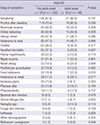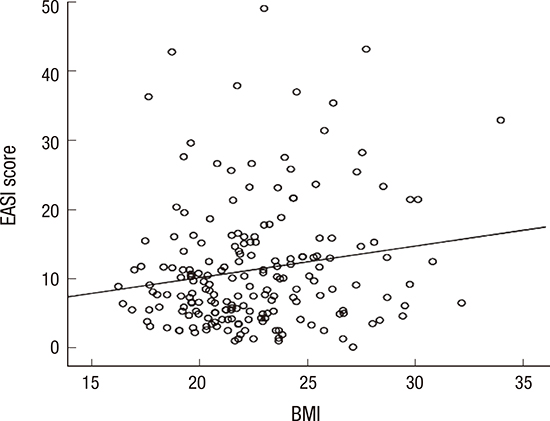1. Williams HC. Epidemiology of atopic dermatitis. Clin Exp Dermatol. 2000; 25:522–529.
2. Hunter JA, Herd RM. Recent advances in atopic dermatitis. Q J Med. 1994; 87:323–327.
3. Tay YK, Khoo BP, Goh CL. The profile of atopic dermatitis in a tertiary dermatology outpatient clinic in Singapore. Int J Dermatol. 1999; 38:689–692.
4. Kim HO, Cho SI, Kim JH, Chung BY, Cho HJ, Park CW, Lee CH. Food hypersensitivity in patients with childhood atopic dermatitis in Korea. Ann Dermatol. 2013; 25:196–202.
5. Silverberg JI, Kleiman E, Lev-Tov H, Silverberg NB, Durkin HG, Joks R, Smith-Norowitz TA. Association between obesity and atopic dermatitis in childhood: a case-control study. J Allergy Clin Immunol. 2011; 127:1180–1186.e1.
6. Kim JH, Kim H, Park CW, Lee CH. Quality of life in adults with atopic dermatitis. Korean J Dermatol. 2011; 49:983–992.
7. Garmhausen D, Hagemann T, Bieber T, Dimitriou I, Fimmers R, Diepgen T, Novak N. Characterization of different courses of atopic dermatitis in adolescent and adult patients. Allergy. 2013; 68:498–506.
8. Rajka G. Essential Aspects of Atopic Dermatitis. [place unknown]: Springer;2012.
9. Sandström Falk MH, Faergemann J. Atopic dermatitis in adults: does it disappear with age? Acta Derm Venereol. 2006; 86:135–139.
10. Pyun BY. Natural history and risk factors of atopic dermatitis in children. Allergy Asthma Immunol Res. 2015; 7:101–105.
11. Sandström MH, Faergemann J. Prognosis and prognostic factors in adult patients with atopic dermatitis: a long-term follow-up questionnaire study. Br J Dermatol. 2004; 150:103–110.
12. Wüthrich B. Clinical aspects, epidemiology, and prognosis of atopic dermatitis. Ann Allergy Asthma Immunol. 1999; 83:464–470.
13. Mortz CG, Andersen KE, Dellgren C, Barington T, Bindslev-Jensen C. Atopic dermatitis from adolescence to adulthood in the TOACS cohort: prevalence, persistence and comorbidities. Allergy. 2015; 70:836–845.
14. Bannister MJ, Freeman S. Adult-onset atopic dermatitis. Australas J Dermatol. 2000; 41:225–228.
15. Roth HL, Kierland RR. The natural history of atopic dermatitis. A 20-year follow-up study. Arch Dermatol. 1964; 89:209–214.
16. Lammintausta K, Kalimo K, Raitala R, Forsten Y. Prognosis of atopic dermatitis. A prospective study in early adulthood. Int J Dermatol. 1991; 30:563–568.
17. Hanifin JM, Thurston M, Omoto M, Cherill R, Tofte SJ, Graeber M. The eczema area and severity index (EASI): assessment of reliability in atopic dermatitis. EASI Evaluator Group. Exp Dermatol. 2001; 10:11–18.
18. Kanwar AJ, Narang T. Adult onset atopic dermatitis: under-recognized or under-reported? Indian Dermatol Online J. 2013; 4:167–171.
19. Ozkaya E. Adult-onset atopic dermatitis. J Am Acad Dermatol. 2005; 52:579–582.
20. Lee JH, Han KD, Jung HM, Youn YH, Lee JY, Park YG, Lee SH, Park YM. Association between obesity, abdominal obesity, and adiposity and the prevalence of atopic dermatitis in young Korean adults: the Korea National Health and Nutrition Examination Survey 2008–2010. Allergy Asthma Immunol Res. 2016; 8:107–114.
21. Kwon JA, Roh KY, Koh BK, Kim JW. Clinical characteristics of adolescence and adult atopic dermatitis in Korea. Korean J Dermatol. 2004; 42:949–954.
22. Kim KH, Park KC. Clinical characteristics of adult atopic dermatitis. Ann Dermatol. 1998; 10:229–232.
23. Chu H, Shin JU, Park CO, Lee H, Lee J, Lee KH. Clinical diversity of atopic dermatitis: a review of 5,000 patients at a single institute. Allergy Asthma Immunol Res. 2017; 9:158–168.
24. Kim KH, Park AY, Kim JS. Factors associated with atopic dermatitis in Korean adults: the Korean National Health and Nutrition Survey 2008. Korean J Rehabil Nurs. 2012; 15:83–90.
25. Chung Y, Kwon JH, Kim J, Han Y, Lee SI, Ahn K. Retrospective analysis of the natural history of atopic dermatitis occurring in the first year of life in Korean children. J Korean Med Sci. 2012; 27:723–728.
26. Nnoruka EN. Current epidemiology of atopic dermatitis in south-eastern Nigeria. Int J Dermatol. 2004; 43:739–744.
27. Haeck IM, Knol MJ, Ten Berge O, van Velsen SG, de Bruin-Weller MS, Bruijnzeel-Koomen CA. Enteric-coated mycophenolate sodium versus cyclosporin A as long-term treatment in adult patients with severe atopic dermatitis: a randomized controlled trial. J Am Acad Dermatol. 2011; 64:1074–1084.
28. Beck LA, Thaçi D, Hamilton JD, Graham NM, Bieber T, Rocklin R, Ming JE, Ren H, Kao R, Simpson E, et al. Dupilumab treatment in adults with moderate-to-severe atopic dermatitis. N Engl J Med. 2014; 371:130–139.
29. Gutgesell C, Heise S, Seubert S, Seubert A, Domhof S, Brunner E, Neumann C. Double-blind placebo-controlled house dust mite control measures in adult patients with atopic dermatitis. Br J Dermatol. 2001; 145:70–74.
30. Koutroulis I, Magnelli L, Gaughan J, Weiner E, Kratimenos P. Atopic dermatitis is more severe in children over the age of two who have an increased body mass index. Acta Paediatr. 2015; 104:713–717.
31. Silverberg JI, Silverberg NB, Lee-Wong M. Association between atopic dermatitis and obesity in adulthood. Br J Dermatol. 2012; 166:498–504.
32. Boulet LP. Obesity and atopy. Clin Exp Allergy. 2015; 45:75–86.
33. Hersoug LG, Linneberg A. The link between the epidemics of obesity and allergic diseases: does obesity induce decreased immune tolerance? Allergy. 2007; 62:1205–1213.
34. Martín-Romero C, Santos-Alvarez J, Goberna R, Sánchez-Margalet V. Human leptin enhances activation and proliferation of human circulating T lymphocytes. Cell Immunol. 2000; 199:15–24.
35. Nagel G, Koenig W, Rapp K, Wabitsch M, Zoellner I, Weiland SK. Associations of adipokines with asthma, rhinoconjunctivitis, and eczema in German schoolchildren. Pediatr Allergy Immunol. 2009; 20:81–88.
36. Salam MT, Wenten M, Gilliland FD. Endogenous and exogenous sex steroid hormones and asthma and wheeze in young women. J Allergy Clin Immunol. 2006; 117:1001–1007.
37. Luo X, Xiang J, Dong X, Cai F, Suo J, Wang Z, Liu M. Association between obesity and atopic disorders in Chinese adults: an individually matched case-control study. BMC Public Health. 2013; 13:12.










 PDF
PDF ePub
ePub Citation
Citation Print
Print




 XML Download
XML Download